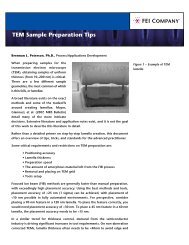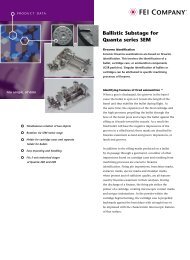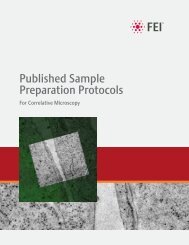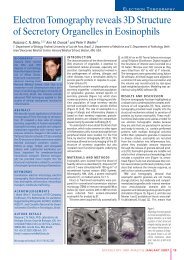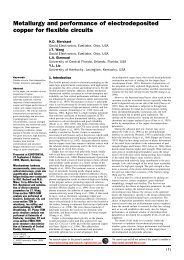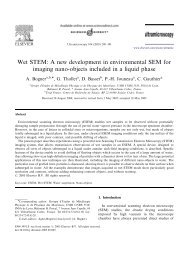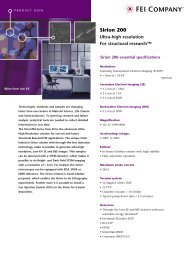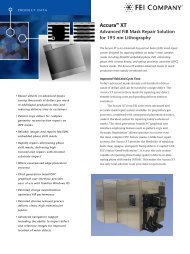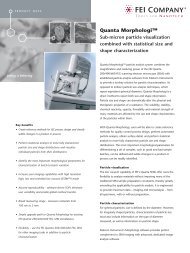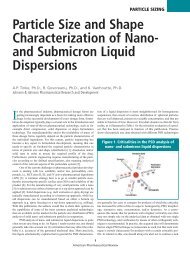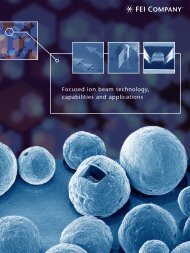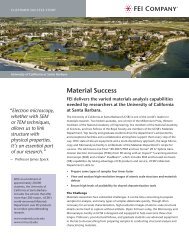Focused Ion Beam Microscopy and Micromachining - Nanolab
Focused Ion Beam Microscopy and Micromachining - Nanolab
Focused Ion Beam Microscopy and Micromachining - Nanolab
You also want an ePaper? Increase the reach of your titles
YUMPU automatically turns print PDFs into web optimized ePapers that Google loves.
<strong>Focused</strong> <strong>Ion</strong> <strong>Beam</strong><br />
<strong>Microscopy</strong> <strong>and</strong><br />
<strong>Micromachining</strong><br />
C.A. Volkert <strong>and</strong> A.M. Minor, Guest Editors<br />
Abstract<br />
The fairly recent availability of commercial focused ion beam (FIB) microscopes has<br />
led to rapid development of their applications for materials science. FIB instruments<br />
have both imaging <strong>and</strong> micromachining capabilities at the nanometer–micrometer scale;<br />
thus, a broad range of fundamental studies <strong>and</strong> technological applications have been<br />
enhanced or made possible with FIB technology. This introductory article covers the<br />
basic FIB instrument <strong>and</strong> the fundamentals of ion–solid interactions that lead to the<br />
many unique FIB capabilities as well as some of the unwanted artifacts associated with<br />
FIB instruments. The four topical articles following this introduction give overviews of<br />
specific applications of the FIB in materials science, focusing on its particular strengths<br />
as a tool for characterization <strong>and</strong> transmission electron microscopy sample preparation,<br />
as well as its potential for ion beam fabrication <strong>and</strong> prototyping.<br />
Introduction<br />
The focused ion beam (FIB) microscope<br />
has gained widespread use in fundamental<br />
materials studies <strong>and</strong> technological<br />
applications over the last several years<br />
because it offers both high-resolution<br />
imaging <strong>and</strong> flexible micromachining in a<br />
single platform.<br />
The FIB instrument is similar to a scanning<br />
electron microscope (SEM), except<br />
that the beam that is rastered over the<br />
sample is an ion beam rather than an electron<br />
beam. Secondary electrons are generated<br />
by the interaction of the ion beam<br />
with the sample surface <strong>and</strong> can be used<br />
to obtain high-spatial-resolution images.<br />
In most commercially available systems,<br />
Ga ions are used, <strong>and</strong> their sputtering<br />
action enables precise machining of samples.<br />
In conjunction with the gas-injection<br />
capabilities on these systems, which<br />
enable ion-beam-activated deposition <strong>and</strong><br />
enhanced etching, a range of sample fabrication<br />
schemes are possible.<br />
During the last 25 years, FIB instrumentation<br />
has become an important technology<br />
for a wide array of materials science<br />
applications, from circuit editing <strong>and</strong><br />
transmission electron microscopy (TEM)<br />
sample preparation to microstructural<br />
analysis <strong>and</strong> prototype nanomachining.<br />
Most modern FIB instruments supple-<br />
ment the FIB column with an additional<br />
SEM column so that the instrument<br />
becomes a versatile “dual-beam” platform<br />
(FIB–SEM, see Figure 1) for imaging,<br />
material removal, <strong>and</strong> deposition at<br />
length scales of a few nanometers to hundreds<br />
of microns. The FIB instrument<br />
becomes a powerful tool for nanomanipulation<br />
<strong>and</strong> fabrication through the augmentation<br />
of an FIB instrument with<br />
micromanipulators <strong>and</strong> gas injection for<br />
local chemical vapor deposition (CVD).<br />
The first FIB instruments evolved from<br />
advances in field ion microscopes 1 <strong>and</strong><br />
through the development of highresolution<br />
liquid metal ion sources<br />
(LMISs). 2–4 In the 1980s, FIB instruments<br />
were embraced by the semiconductor<br />
industry as offline equipment for mask or<br />
circuit repair. It was not until the 1990s<br />
that FIB instruments began to be used in<br />
research laboratories, <strong>and</strong> today there are<br />
commercial instruments available from<br />
multiple manufacturers. 5 With the popularity<br />
of FIB instruments for TEM sample<br />
preparation, microstructural analysis, <strong>and</strong><br />
nanomachining, dual-beam FIB instruments<br />
are becoming a versatile <strong>and</strong> powerful<br />
tool for materials researchers.<br />
This introductory article focuses on<br />
the FIB instrument itself <strong>and</strong> the basic<br />
ion–solid interactions that lead to the various<br />
functionalities of FIBs. In the topical<br />
articles that follow, the major subspecialties<br />
of FIB research are discussed.<br />
The FIB Instrument<br />
The basic functions of the FIB, namely,<br />
imaging <strong>and</strong> sputtering with an ion beam,<br />
require a highly focused beam. A consistent<br />
tenet of any focused beam is that the<br />
smaller the effective source size, the more<br />
current that can be focused to a point.<br />
Unlike the broad ion beams generated<br />
from plasma sources, high-resolution<br />
ion beams are defined by the use of a field<br />
ionization source with a small effective<br />
source size on the order of 5 nm, therefore<br />
enabling the beam to be tightly focused.<br />
The ion source type used in all commercial<br />
systems <strong>and</strong> in the majority of<br />
research systems designed with micromachining<br />
applications in mind is the liquidmetal<br />
ion source (LMIS). 6,7 Of the existing<br />
ion source types, the LMIS provides the<br />
brightest <strong>and</strong> most highly focused beam<br />
(when connected to the appropriate<br />
optics). There are a number of different<br />
types of LMIS sources, the most widely<br />
used being a Ga-based blunt needle<br />
source. Ga has decided advantages over<br />
other LMIS metals such as In, Bi, Sn, <strong>and</strong><br />
Au because of its combination of low<br />
melting temperature (30∞C), low volatility,<br />
<strong>and</strong> low vapor pressure. The low melting<br />
temperature makes the source easy to<br />
design <strong>and</strong> operate, <strong>and</strong> because Ga does<br />
not react with the material defining the<br />
needle (typically W) <strong>and</strong> evaporation is<br />
negligible, Ga-based LMISs are typically<br />
more stable than other LMIS metals.<br />
During operation, Ga flows from a reservoir<br />
to the needle tip (with an end radius<br />
of about 10 mm), where it is extracted by<br />
field emission. A large negative potential<br />
between the needle <strong>and</strong> an extraction<br />
electrode generates an electric field of<br />
magnitude 10 10 V/m at the needle tip. The<br />
balance between the electrostatic forces<br />
<strong>and</strong> the Ga surface tension wetting the<br />
tapered W needle geometry results in<br />
the formation of a single Taylor cone at the<br />
needle tip. For typical emission currents<br />
used in FIB microscopes (~2 mA), a cusp<br />
forms at the tip of the Taylor cone with a<br />
tip radius of approximately 5 nm.<br />
The simplest <strong>and</strong> most widely used ion<br />
beam columns consist of two lenses (a<br />
condenser <strong>and</strong> objective lens) to define<br />
the beam <strong>and</strong> then focus it on the sample,<br />
beam-defining apertures to select the<br />
beam diameter <strong>and</strong> current, deflection<br />
plates to raster the beam over the sample<br />
surface, stigmation poles to ensure a<br />
spherical beam profile, <strong>and</strong> a high-speed<br />
beam blanker to quickly deflect the beam<br />
MRS BULLETIN • VOLUME 32 • MAY 2007 • www/mrs.org/bulletin 389
<strong>Focused</strong> <strong>Ion</strong> <strong>Beam</strong> <strong>Microscopy</strong> <strong>and</strong> <strong>Micromachining</strong><br />
Figure 1. Schematic illustration of a dual-beam FIB–SEM instrument. Exp<strong>and</strong>ed view<br />
shows the electron <strong>and</strong> ion beam sample interaction.<br />
off the sample <strong>and</strong> onto a beam stop such<br />
as a Faraday cup. Because the focusing<br />
strength of an electromagnetic lens is<br />
directly related to the charge/mass ratio<br />
of a particle, it is impractical to build electromagnetic<br />
lenses for ions (which would<br />
weigh thous<strong>and</strong>s of kilograms); thus,<br />
focusing <strong>and</strong> steering are performed using<br />
electrostatic components rather than the<br />
electromagnetic components used for<br />
electrons.<br />
The size <strong>and</strong> shape of the beam intensity<br />
profile on the sample determines the basic<br />
imaging resolution <strong>and</strong> micromachining<br />
precision. Generally, the smaller the beam<br />
diameter, the better the achievable resolution<br />
<strong>and</strong> milling precision, although the<br />
requirements for the two applications are<br />
not exactly the same. 8 For the energies,<br />
currents, <strong>and</strong> acceptance angles used in<br />
typical FIB systems, the beam spot size is<br />
limited mostly by the chromatic aberration<br />
that results primarily from the energy<br />
spread of the beam due to space charge<br />
effects at the ion source <strong>and</strong> secondarily<br />
from the spherical aberration of the lenses.<br />
However, the ultimate spatial resolution<br />
for FIB imaging is, in fact, limited by sputtering<br />
<strong>and</strong> is thus sample-dependent. 9 In<br />
modern FIB systems, the imaging resolution<br />
determined by the sputter-limited signal/noise<br />
usually is about 10 nm.<br />
The sample is mounted on a grounded<br />
stage with three-axis translation, rotation,<br />
<strong>and</strong> tilt capabilities. The stage is designed<br />
to have a eucentric point (i.e., a wellcentered<br />
point such that the field of view<br />
is maintained when tilting the specimen)<br />
at the location where the two beams cross<br />
(or at the working distance of the ion<br />
beam, in the case of a single-beam FIB).<br />
The region of interest on the sample is<br />
moved to the eucentric point using translation<br />
<strong>and</strong> rotation <strong>and</strong> then tilted for the<br />
desired angle of beam incidence. The total<br />
current on the sample (sum of the incoming<br />
ion or electron beam <strong>and</strong> all emitted<br />
charged particles) is measured at the<br />
stage.<br />
Depending on the application, the various<br />
emitted particles or radiation can be<br />
detected with appropriate detectors in the<br />
sample chamber. Traditional detectors<br />
such as those in an SEM can be used to<br />
detect the electrons or x-rays created by<br />
the interaction of the ion beam with the<br />
sample. The ions sputtered from the sample<br />
can also be detected using a variety of<br />
detectors such as charge electron multipliers,<br />
<strong>and</strong> mass selection of the sputtered<br />
charged particles is also possible (secondary<br />
ion mass spectrometry). FIBs derive<br />
an important additional functionality<br />
through the use of gas-injection sources to<br />
deliver gas locally to either enhance the<br />
etching rate or result in site-specific CVD.<br />
Secondary electrons generated by the incident<br />
ion beam (or, alternatively, the<br />
incident electron beam in dual-beam systems)<br />
can crack hydrocarbon precursor<br />
gases, leading to local deposition of the<br />
conducting material (W, Pt, or C) or insulating<br />
material (SiO 2 ); see the article by<br />
MoberlyChan et al. in this issue. The local<br />
deposition of material also enables sophisticated<br />
micromanipulation within the FIB<br />
chamber, made possible through micromanipulation<br />
accessories <strong>and</strong> the ability<br />
of the FIB to cut (sputter), paste (deposit),<br />
<strong>and</strong> watch (image) during a manipulation<br />
process within the chamber. The result is a<br />
system that can image, analyze, sputter,<br />
<strong>and</strong> deposit material all with very high<br />
spatial resolution <strong>and</strong> controlled through<br />
one software program. In a large part, it is<br />
this multifunctional versatility that has<br />
made FIB instruments popular among<br />
materials researchers.<br />
<strong>Ion</strong>–Solid Interactions<br />
<strong>Ion</strong>–solid interactions play an important<br />
role in many different endeavors, ranging<br />
from fabrication of microelectronic devices<br />
to underst<strong>and</strong>ing distributions of cosmic<br />
gases. This brief introduction will be<br />
limited to the processes <strong>and</strong> conditions<br />
relevant to the use of FIB systems in materials<br />
science. For more detailed descriptions<br />
of ion–solid interactions, the reader<br />
is referred to books <strong>and</strong> review articles<br />
on the subject 6,10–12 as well as to literature<br />
specifically on FIB. 13–15<br />
When an ion impinges on a solid, it<br />
loses kinetic energy through interactions<br />
with the sample atoms. This transfer<br />
of energy from the ion to the solid results<br />
in a number of different processes (see<br />
Figure 2):<br />
� ion reflection <strong>and</strong> backscattering<br />
� electron emission<br />
� electromagnetic radiation<br />
� atomic sputtering <strong>and</strong> ion emission<br />
� sample damage<br />
� sample heating<br />
The ion typically comes to rest in the<br />
solid, leading to implantation of the ion.<br />
With the possible exception of electromagnetic<br />
radiation generation, all of these<br />
processes are important to FIB <strong>and</strong><br />
FIB–SEM system applications <strong>and</strong> are<br />
described in the next sections.<br />
Collision Cascade<br />
<strong>Ion</strong> kinetic energy <strong>and</strong> momentum are<br />
transferred to the solid through both<br />
inelastic <strong>and</strong> elastic interactions. In inelastic<br />
interactions (called electronic energy<br />
loss), ion energy is lost to the electrons in<br />
the sample <strong>and</strong> results in ionization <strong>and</strong><br />
the emission of electrons <strong>and</strong> electromagnetic<br />
radiation from the sample. In elastic<br />
interactions (called nuclear energy loss),<br />
ion energy is transferred as translational<br />
energy to screened target atoms <strong>and</strong> can<br />
result in damage (displacement of sample<br />
390 MRS BULLETIN • VOLUME 32 • MAY 2007 • www/mrs.org/bulletin
<strong>Focused</strong> <strong>Ion</strong> <strong>Beam</strong> <strong>Microscopy</strong> <strong>and</strong> <strong>Micromachining</strong><br />
Figure 2. Schematic illustration of a collision cascade generated by a 30 keV Ga + ion<br />
incident on a crystal lattice, showing the damage created in the collision cascade volume,<br />
<strong>and</strong> the projected range R p <strong>and</strong> lateral range R l of the implanted ion.<br />
atoms from their initial sites) <strong>and</strong> sputtering<br />
from the sample surface.<br />
The most widely accepted concept for<br />
ion–solid interactions is the collision cascade<br />
model 16,17 (Figure 2). For the case of<br />
5–30 keV Ga impinging on most solids,<br />
the collision cascade involves a series of<br />
independent binary collisions (the linear<br />
collision cascade regime). If the translational<br />
energy transferred to a target atom<br />
during a collision exceeds a critical value<br />
called the displacement energy, the atom<br />
will be knocked out of its original site, for<br />
example, creating an interstitial–vacancy<br />
pair in a crystalline sample. This primary<br />
recoil atom may have sufficient energy to<br />
displace further sample atoms (secondary<br />
recoils), thus generating a volume where<br />
large numbers of atoms have excess<br />
kinetic energy. If a displacement collision<br />
occurs near the surface, the recoil atom<br />
may be emitted from the solid <strong>and</strong> lead to<br />
sputtering. The displacement energy (typically<br />
on the order of 20 eV) is much larger<br />
than the binding energy for the atoms (of<br />
the order of 1 eV), reflecting the fact that<br />
the collisions are nonadiabatic, because of<br />
the very short time scale.<br />
After approximately 10 –11 s, the 5–30<br />
keV Ga ion comes to rest in the solid, <strong>and</strong><br />
the energies of all particles participating in<br />
the cascade have decreased below the displacement<br />
energy. At this point, the collision<br />
cascade has ended. What remains are<br />
the emitted particles <strong>and</strong> radiation, <strong>and</strong><br />
ion beam damage such as lattice defects,<br />
incorporated Ga, <strong>and</strong> heat, all of which<br />
may continue to interact <strong>and</strong> evolve.<br />
Molecular dynamics calculations are<br />
ideally suited for simulating collision<br />
cascades, because of the short length <strong>and</strong><br />
time scales. Monte Carlo calculations are<br />
also well suited to simulating ion–solid<br />
interactions by including the “frictional”<br />
electronic stopping <strong>and</strong> stochastic elastic<br />
collisions. The most widely used Monte<br />
Carlo simulation is the program TRIM<br />
or SRIM (transport, or stopping range, of<br />
ions in matter). 18 Such calculations for 30<br />
keV Ga into elements from Li to Bi show<br />
that roughly two times as much of the ion<br />
energy is lost to nuclear energy losses than<br />
to ionization energy losses (the former<br />
from interactions with the nucleus of an<br />
atom <strong>and</strong> the latter from interactions with<br />
the electrons). Of the nuclear energy<br />
losses, the majority is lost through sample<br />
atom vibrations or heating rather than<br />
through vacancy formation.<br />
The projected <strong>and</strong> lateral ranges of the<br />
30 keV Ga scale inversely with the sample<br />
density <strong>and</strong> are between 10 nm <strong>and</strong> 100<br />
nm (projected) <strong>and</strong> between 5 nm <strong>and</strong> 50<br />
nm (lateral). TRIM sputtering yields<br />
(sputtered target atoms per incoming<br />
ion) are between 1 <strong>and</strong> 20 for normalincidence<br />
30 keV Ga <strong>and</strong> increase somewhat<br />
with atomic number. 6 However,<br />
sputtering yield predictions depend critically<br />
on surface binding energies, which<br />
are not well known <strong>and</strong> are sensitive<br />
to surface structure <strong>and</strong> chemistry. TRIM<br />
vacancy generation predictions between<br />
300 <strong>and</strong> 1000 vacancies per incoming<br />
ion are overestimates because defect<br />
diffusion <strong>and</strong> interactions are ignored. In<br />
addition, discrepancies between experimental<br />
<strong>and</strong> simulated ranges <strong>and</strong> collision<br />
cascade shapes in crystals can be<br />
expected, because TRIM samples are<br />
isotropic <strong>and</strong> cannot capture channeling<br />
effects. Despite these limitations, such calculations<br />
are invaluable in predicting<br />
trends <strong>and</strong> in estimating the effects of<br />
ion–solid interactions.<br />
<strong>Ion</strong> <strong>Beam</strong> Imaging<br />
In the same manner that images are<br />
generated in an SEM, the ion beam can be<br />
rastered over a sample surface <strong>and</strong> the<br />
emitted electrons, particles (atoms <strong>and</strong><br />
MRS BULLETIN • VOLUME 32 • MAY 2007 • www/mrs.org/bulletin 391
<strong>Focused</strong> <strong>Ion</strong> <strong>Beam</strong> <strong>Microscopy</strong> <strong>and</strong> <strong>Micromachining</strong><br />
ions), <strong>and</strong> electromagnetic radiation can<br />
be detected. Conventional SEM imaging is<br />
based on detecting the secondary electrons<br />
(SEs). To date, most imaging in a FIB<br />
is based on detecting the low-energy electrons,<br />
often referred to as ion-induced secondary<br />
electrons (ISEs). Typically, 1–10<br />
electrons with energies below 10 eV are<br />
generated per incoming 5–30 keV Ga ion.<br />
These electrons are created by both kinetic<br />
<strong>and</strong> potential emission from the top few<br />
atomic layers where the primary ion<br />
impacts the solid as well as where<br />
backscattered or sputtered particles exit<br />
the sample. The total low-energy electron<br />
yield depends strongly on surface oxidation<br />
<strong>and</strong> contamination <strong>and</strong> thus will<br />
change as the surface is sputter-cleaned<br />
<strong>and</strong> Ga is incorporated.<br />
<strong>Ion</strong> beams are not as finely focused as<br />
electron beams <strong>and</strong>, partly for this reason,<br />
they generally offer lower resolution.<br />
However, the contrast mechanisms for ISE<br />
generation are different from those for<br />
SE generation <strong>and</strong> can offer complementary<br />
information about a sample surface.<br />
SE <strong>and</strong> ISE images of the same sample are<br />
shown in Figure 3. Both the SE (Figure 3a)<br />
<strong>and</strong> the ISE (Figure 3b) images show contrast<br />
due to surface topography <strong>and</strong> material<br />
differences. However, ISE imaging<br />
typically delivers stronger channeling contrast<br />
from crystals than SE imaging. The<br />
contrast due to crystal orientation is easily<br />
distinguished from material contrast,<br />
because crystal contrast changes with the<br />
incidence angle of the ion beam <strong>and</strong> material<br />
contrast does not. In ideal samples<br />
such as Cu or Au, ISE channeling contrast<br />
can reveal twin lamellae as narrow as 20<br />
nm <strong>and</strong> grains as small as 50 nm.<br />
The different contrast mechanisms are<br />
illustrated in Figure 4. A comparison of<br />
Figures 4a <strong>and</strong> 4b shows that when the<br />
crystal is oriented so that the ion “channels”<br />
along crystal planes, there are fewer<br />
ion interactions with sample atoms near the<br />
surface <strong>and</strong> thus fewer electrons are emitted.<br />
Figure 4c illustrates that heavier samples<br />
typically result in more ISEs (<strong>and</strong> SEs).<br />
Figure 4d shows that surface topography<br />
can lead to increases in the number of ISEs<br />
(<strong>and</strong> SEs), because of the increase in the<br />
number of ion–solid interactions near the<br />
sample surface. The SE <strong>and</strong> ISE images are<br />
also often distinguished by the amount of<br />
charging generated in insulating samples.<br />
Presumably because of differences in<br />
the low-energy/secondary electron yields<br />
<strong>and</strong> to the fact that the Ga implantation<br />
creates a thin conducting layer at the sample<br />
surface, the FIB can often be used to<br />
image uncoated samples that are difficult<br />
to image even with low-voltage SEM.<br />
However, it is important to remember that<br />
ion beam imaging always results in some<br />
Ga implantation <strong>and</strong> sputtering of the<br />
sample surface.<br />
Figure 3. (a) Secondary electron (SE)<br />
<strong>and</strong> (b) ion-induced secondary electron<br />
(ISE) images of an FIB-cut cross<br />
section in brass. Surface topography<br />
generated during the FIB milling <strong>and</strong><br />
phase contrast are visible in both<br />
images. The heavier second-phase<br />
precipitates are bright in the SE image<br />
<strong>and</strong> dark in the ISE image. 37 Channeling<br />
contrast showing the grain structure is<br />
visible only in the ISE image.<br />
<strong>Ion</strong> <strong>Beam</strong> Sputtering<br />
Because of the sputtering action of the<br />
ion beam, the FIB can be used to locally<br />
remove or mill away material. For example,<br />
a Sn sphere is progressively sputtered<br />
over a defined area in Figure 5. For direct<br />
milling, the limiting feature size is typically<br />
about 10 nm 9,19,20 (see the articles by<br />
MoberlyChan et al. <strong>and</strong> Langford et al. in<br />
this issue). Quantitative aspects of sputtering<br />
are complicated <strong>and</strong> depend on the<br />
material, crystal orientation, ion beam<br />
incidence angle, <strong>and</strong> the extent of redeposition.<br />
As the incidence angle of the ion beam<br />
is increased, the intersection of the collision<br />
cascade with the sample surface<br />
increases, <strong>and</strong> the number of sputtered<br />
atoms per collision cascade increases<br />
(a similar effect of geometry on electron<br />
emission is shown in Figure 4d).<br />
However, at the same time, the fraction<br />
of reflected or backscattered Ga ions<br />
increases. The combination of these two<br />
effects leads to a maximum in sputtering<br />
yield at an incidence angle of approximately<br />
75–80∞. This effect has been confirmed<br />
for 25–30 keV Ga into a variety of<br />
materials, including single-crystal Si, 19–22<br />
amorphous SiO 2 , 21,22 <strong>and</strong> polycrystalline<br />
Au <strong>and</strong> W 21 <strong>and</strong> shows good agreement<br />
between experiment <strong>and</strong> theory. Si or<br />
amorphous solids are ideal for such a<br />
study because the effects of crystal channeling<br />
are avoided (the surface region of<br />
Si amorphizes under the Ga beam 7 ). The<br />
behavior is more complicated in crystalline<br />
material where both incident angle<br />
<strong>and</strong> channeling effects are present. 21<br />
The sputtering yield at a given incidence<br />
angle can vary by as much as a factor<br />
of 10 for strongly channeling crystal<br />
orientations in materials such as Cu. 23 This<br />
is because for easy channeling orienta-<br />
Figure 4. Schematics showing the influence of (a), (b) crystal orientation, (c) atomic mass,<br />
<strong>and</strong> (d) surface geometry on 30 keV Ga + collision cascades <strong>and</strong> ISE image contrast<br />
formation. The orange atoms in (c) are more massive than the yellow atoms in (a), (b), <strong>and</strong><br />
(d). Similar concepts influence sputtering yields.<br />
392 MRS BULLETIN • VOLUME 32 • MAY 2007 • www/mrs.org/bulletin
<strong>Focused</strong> <strong>Ion</strong> <strong>Beam</strong> <strong>Microscopy</strong> <strong>and</strong> <strong>Micromachining</strong><br />
tions, the ion experiences only inelastic<br />
glancing-angle collisions with the atoms<br />
lying in a crystal plane <strong>and</strong> travels deeper<br />
into the crystal before causing elastic collisions,<br />
so that fewer atoms are sputtered<br />
from the surface. This is analogous to the<br />
effect of crystal orientation on low-energy<br />
electron yields illustrated in Figures 4a<br />
<strong>and</strong> 4b. Channeling effects on sputtering<br />
at a vertical grain boundary in Cu are<br />
shown in Figure 6. The grain with the<br />
smaller electron yield appears dark in<br />
Figure 6. Its lower sputter yield results in<br />
a shallower sputter profile than that<br />
observed for the brighter neighboring<br />
grain.<br />
The sputter profiles also depend on the<br />
exact sequence in which the ion beam is<br />
Figure 5. (a)–(c) Secondary electron<br />
images during sputtering of a large Sn<br />
sphere surrounded by Sn droplets,<br />
using a 30 keV Ga beam rastered<br />
across a 10 mm ¥ 10 mm area.<br />
rastered over the surface. 22 For instance,<br />
the sputter profile of a ring cut by rapid<br />
<strong>and</strong> repetitive scanning (“multi-pass”<br />
scanning) differs from that obtained by<br />
slowly scanning the beam just once over<br />
the same area (“single-pass” scanning)<br />
(Figure 6). Despite an identical total<br />
ion dose (ions per unit area) for both rings<br />
in Figure 6, the slow single-pass scan,<br />
spiraling from outside to inside, results in<br />
a deeper cut, because of effects of ion<br />
focusing, incident angle effects, <strong>and</strong> redeposition.<br />
Redeposition decreases the effective<br />
sputter yield <strong>and</strong> changes sputter profiles.<br />
The decreased yield comes about because<br />
redeposited material l<strong>and</strong>s in the area<br />
being sputtered <strong>and</strong> must be sputtered a<br />
second time. Redeposition is also given as<br />
a reason why completely vertical sidewalls<br />
cannot be cut with the FIB without<br />
over-tilting the sample, 13,24 but it is certainly<br />
also partly because of the intensity<br />
tails of the ion beam profile <strong>and</strong> of the<br />
decrease in sputter yield at high incidence<br />
angles. 19,20,25 Many details of redeposition<br />
effects remain open, such as the development<br />
of crystal orientation <strong>and</strong> channeling<br />
effects seen in the redeposited material<br />
(e.g., Figure 6, single-pass ring).<br />
In addition to redeposition, surface<br />
roughening <strong>and</strong> shadowing effects are<br />
prevalent during sputtering. An example<br />
of a shadowing effect on topology during<br />
cross-sectioning with the FIB, the so-called<br />
“curtain effect,” 13 is seen in the lower half<br />
of the images in Figure 3. Surface roughening,<br />
specifically ripple formation, is<br />
widespread during ion bombardment 9,26<br />
<strong>and</strong> is attributed to competition between<br />
smoothing by surface diffusion or viscous<br />
flow <strong>and</strong> roughening because of surfacecurvature-dependent<br />
sputter yields. (The<br />
sputter yield depends on local curvature<br />
for the same reasons it depends on angle<br />
of incidence.)<br />
Even during normal-incidence sputtering,<br />
surface roughening can occur <strong>and</strong> is<br />
dependent on the crystal orientation, as<br />
shown in the multi-pass ring cut across<br />
two differently oriented grains in Figure<br />
6. Such crystal-orientation-dependent<br />
rippling is attributed to anisotropic surface<br />
diffusion. 27 Other unusual effects<br />
of sputtering <strong>and</strong> redeposition on surface<br />
evolution continue to be discovered. 28,29<br />
Nonetheless, progress is being made<br />
toward models that can predict surface<br />
evolution during sputtering <strong>and</strong> can be<br />
used to achieve desired sputter profiles<br />
(see the article by Langford et al. in this<br />
issue).<br />
Ga Incorporation<br />
Imaging <strong>and</strong> milling with Ga ions<br />
always result in Ga incorporation near the<br />
sample surface. As the sample surface is<br />
sputtered away at a rate proportional to<br />
the sputtering yield <strong>and</strong> the ion flux (ions<br />
per area per time), the Ga is implanted<br />
Figure 6. <strong>Ion</strong>-induced secondary electron image of rings milled with 30 keV Ga at a grain<br />
boundary in Cu. The single-pass ring shows an enhanced sputtering yield (deeper trough)<br />
<strong>and</strong> redeposition (sloped, thicker sidewalls); the multi-pass ring shows channeling effects<br />
<strong>and</strong> surface roughening.<br />
MRS BULLETIN • VOLUME 32 • MAY 2007 • www/mrs.org/bulletin 393
<strong>Focused</strong> <strong>Ion</strong> <strong>Beam</strong> <strong>Microscopy</strong> <strong>and</strong> <strong>Micromachining</strong><br />
further into the sample, <strong>and</strong> a steady-state<br />
profile of Ga is reached. The maximum Ga<br />
concentration occurs at steady state after<br />
the removal of target material to a depth<br />
roughly equal to the ion range <strong>and</strong> is constant<br />
over a depth also roughly equal to<br />
the ion range. Ignoring the effects from<br />
possible diffusion of Ga in the target material,<br />
differences in molar volume, <strong>and</strong><br />
preferential sputtering, the Ga atom fraction<br />
at steady state is<br />
f Ga = 1/(aY), (1)<br />
where a is the fraction of ions that are<br />
not reflected or backscattered from the<br />
sample surface, Y is the sputtering yield<br />
(number of sputtered atoms/ions per<br />
incoming ion) 10 <strong>and</strong> aY is the sputtering<br />
yield per implanted ion. Based on this<br />
equation <strong>and</strong> typical TRIM sputtering<br />
yields (from 1 to 20 sputtered atoms<br />
per incoming ion), atom fractions from<br />
1 at.% to 50 at.% Ga are expected near the<br />
sample surface. Because of the increase in<br />
sputter yield with incident angle, the<br />
steady-state Ga concentration is expected<br />
to be roughly 5–10 times smaller during<br />
glancing-angle sputtering than normalincidence<br />
sputtering. In contrast, channeling<br />
is expected to raise the steady-state Ga<br />
concentration.<br />
Most studies report Ga concentrations<br />
in good agreement with simulations <strong>and</strong><br />
theory, although a few claim to see almost<br />
no Ga. Unless the Ga diffuses away or<br />
is reflected, it must end up in the surface<br />
region of the sample. Some studies were<br />
performed with energy-dispersive spectroscopy<br />
in an SEM, which for typical electron<br />
beam parameters will look through<br />
the thin Ga-doped layer at the surface <strong>and</strong><br />
underestimate the actual Ga concentration.<br />
Other studies have used surface Auger<br />
analysis (without sputtering) that may<br />
also underestimate the Ga concentration,<br />
because of the presence of carbonaceous or<br />
oxide surface layers. Carbon-based surface<br />
layers are particularly prevalent in samples<br />
that have been imaged in the SEM<br />
after FIB milling. 30 In contrast, Auger<br />
depth profiles or chemical analysis in<br />
the TEM give reasonable agreement<br />
with predictions for both Ga concentration<br />
<strong>and</strong> range (allowing for channeling<br />
effects).<br />
All of these considerations become<br />
much more complicated in alloys or if Ga<br />
diffusion or reactions take place. One<br />
unusual example is the formation of Gacontaining<br />
surface phases during imaging<br />
of certain fcc metals (see the article by<br />
Mayer et al. in this issue). This phenomenon,<br />
which is coupled with sample crystal<br />
structure <strong>and</strong> channeling effects, limits the<br />
ability to obtain high-quality images from<br />
certain materials.<br />
<strong>Ion</strong> <strong>Beam</strong> Damage<br />
A major drawback of FIB imaging <strong>and</strong><br />
machining, particularly for TEM samples,<br />
is the damage created by the ion beam<br />
(again, see Mayer et al. in this issue).<br />
As the ion dose increases, the individual<br />
disordered cascade regions overlap <strong>and</strong><br />
a damaged surface layer is formed.<br />
Depending in particular on the sample<br />
material <strong>and</strong> temperature, the ion beam<br />
damage can take the form of sample surface<br />
amorphization, point defect creation,<br />
dislocation formation, phase formation,<br />
grain modification, or other unusual<br />
effects. With the exception of Si amorphization,<br />
systematic investigations of FIB<br />
damage are just beginning. Nonetheless,<br />
several trends can be identified based on<br />
literature results for broad beam ions <strong>and</strong><br />
on anecdotal FIB observations.<br />
<strong>Ion</strong> beam amorphization is a wellknown<br />
phenomenon <strong>and</strong> has been extensively<br />
studied for covalently bound<br />
materials such as Si, Ge, GaAs, <strong>and</strong> C<br />
(diamond). Because of the highly directional<br />
nature of the atomic bonds in<br />
covalent materials <strong>and</strong> in certain alloys,<br />
the atomic rearrangements necessary to<br />
heal the disorder created by the ion beam<br />
are often hindered. In contrast, pure metals<br />
have nondirectional bonding <strong>and</strong> do<br />
not amorphize. Thus, thin amorphous<br />
layers sometimes observed at the edge<br />
of pure metal TEM samples made by<br />
FIB presumably contain impurities such<br />
as Ga, C, or O. Some oxygen gets in<br />
because of the relatively poor quality of<br />
the vacuum.<br />
Point defects <strong>and</strong> dislocation loops<br />
can also be created during FIB imaging<br />
<strong>and</strong> machining. Systematic studies of FIBinduced<br />
defects have not been undertaken,<br />
although there are many isolated<br />
observations, both published <strong>and</strong> unpublished.<br />
For example, Cu is prone to extensive<br />
FIB damage, 31 as shown in the TEM<br />
image in Figure 7, but Al is not <strong>and</strong><br />
even provides reasonable-quality highresolution<br />
TEM samples. 32 Tooth enamel<br />
(hydroxyapatite) is resistant to FIBinduced<br />
damage, 33 but other apatite<br />
crystals that decompose at lower temperatures<br />
amorphize easily. Several additional<br />
<strong>and</strong> unusual types of damage<br />
have been observed in FIB-milled samples.<br />
These include the formation of Gacontaining<br />
surface phases (see Mayer<br />
et al., this issue) as well as ion-beaminduced<br />
grain growth in fine-grained Ni<br />
<strong>and</strong> Ni alloys. 34 Preferential sputtering,<br />
which is prevalent during FIB milling of<br />
materials that decompose at low tempera-<br />
Figure 7. (a) Transmission electron<br />
microscopy (TEM) image of a Cu film,<br />
showing that the existing dislocation<br />
structure was modified by FIB milling.<br />
(b) Schematic illustration of the milling<br />
geometry. (TEM image courtesy of G.P.<br />
Zhang.)<br />
tures, can lead to chemical changes in the<br />
surface region <strong>and</strong> influence the ease of<br />
damage formation <strong>and</strong> amorphization.<br />
<strong>Ion</strong> <strong>Beam</strong> Heating<br />
During ion implantation, almost all of<br />
the ion kinetic energy is eventually<br />
converted to heat, with only a small fraction<br />
stored as defects in the sample or<br />
emitted as energetic particles or radiation.<br />
14 For times longer than approximately<br />
a nanosecond <strong>and</strong> distances larger<br />
than around 100 nm, the ion beam can<br />
be approximated as a continuous heat<br />
source. At shorter times, there are large<br />
temporal variations in heating, <strong>and</strong> at<br />
times of less than 10 –12 s, the atoms barely<br />
have time to interact with each other, <strong>and</strong><br />
the temperature of the solid is not well<br />
defined. 15 The maximum temperature<br />
reached in a sample depends on the beam<br />
power P, sample thermal conductivity k,<br />
sample geometry, <strong>and</strong> contact to a heat<br />
reservoir. 15,35 <strong>Beam</strong> powers in commercial<br />
systems have maximum values of 1 mW.<br />
394 MRS BULLETIN • VOLUME 32 • MAY 2007 • www/mrs.org/bulletin
<strong>Focused</strong> <strong>Ion</strong> <strong>Beam</strong> <strong>Microscopy</strong> <strong>and</strong> <strong>Micromachining</strong><br />
When the ion beam is incident on a flat<br />
surface, the transfer of heat away from the<br />
incidence point is so effective that even in<br />
the absence of a heat reservoir (e.g., for a<br />
semi-infinite sample), a finite steady-state<br />
temperature increase is reached given by 36<br />
T = P/(pak), (2)<br />
where a is the radius of the circular ion<br />
beam profile on the sample surface. For<br />
values of P/a available in commercial<br />
FIBs, between 1 W/m <strong>and</strong> 1000 W/m, the<br />
temperature rise predicted by Equation 2<br />
can range from entirely negligible for samples<br />
with good thermal conductivity to<br />
huge for poor conductors. For example,<br />
for Si (k = 148 W/m K) the temperature<br />
increase is
<strong>Focused</strong> <strong>Ion</strong> <strong>Beam</strong> <strong>Microscopy</strong> <strong>and</strong> <strong>Micromachining</strong><br />
Cynthia A. Volkert Andrew M. Minor David P. Adams Michael J. Aziz Yongqi Fu<br />
Cynthia A. Volkert,<br />
Guest Editor for this issue<br />
of MRS Bulletin, is a<br />
research scientist <strong>and</strong><br />
group leader at<br />
Forschungszentrum<br />
Karlsruhe in Germany,<br />
where she specializes in<br />
microstructure <strong>and</strong><br />
mechanical properties<br />
studies of small metal<br />
structures. She received a<br />
bachelor’s degree in<br />
physics from McGill<br />
University <strong>and</strong> her PhD<br />
degree from Harvard<br />
University. Volkert then<br />
spent 10 years working as<br />
a staff scientist at Bell<br />
Laboratories before moving<br />
to Germany, first to<br />
the Max Planck Institute<br />
for Metals Research in<br />
Stuttgart <strong>and</strong> then to<br />
Karlsruhe.<br />
Volkert can be reached<br />
at Institut für<br />
Materialforschung II,<br />
Forschungszentrum<br />
Karlsruhe, Postfach 36<br />
40 76021, Karlsruhe,<br />
Germany; tel. 49-7247-<br />
82-3577, fax 49-4247-<br />
82-2347, <strong>and</strong> e-mail<br />
cynthia.volkert@imf.<br />
fzk.de.<br />
Andrew M. Minor, Guest<br />
Editor for this issue of<br />
MRS Bulletin, is a staff scientist<br />
<strong>and</strong> principal investigator<br />
at the National<br />
Center for Electron<br />
<strong>Microscopy</strong> at Lawrence<br />
Berkeley National<br />
Laboratory in Berkeley,<br />
California. He received a<br />
bachelor’s degree in economics<br />
<strong>and</strong> mechanical<br />
engineering from Yale<br />
University <strong>and</strong> MS <strong>and</strong><br />
PhD degrees in materials<br />
science <strong>and</strong> engineering<br />
from the University of<br />
California, Berkeley. His<br />
research group focuses on<br />
the mechanical properties<br />
of small volumes, in situ<br />
TEM technique development,<br />
<strong>and</strong> sample manipulation<br />
<strong>and</strong> preparation<br />
methods for electron<br />
microscopy investigations<br />
of both hard <strong>and</strong> soft<br />
materials.<br />
Minor can be reached<br />
at Lawrence Berkeley<br />
National Laboratory, 1<br />
Cyclotron Rd., MS 72,<br />
Berkeley, CA 94720 USA;<br />
tel. 510-495-2749, fax 510-<br />
486-5888, <strong>and</strong> e-mail<br />
aminor@lbl.gov.<br />
David P. Adams is a distinguished<br />
member of<br />
technical staff at S<strong>and</strong>ia<br />
National Laboratories.<br />
Adams received his bachelor’s<br />
degree in physics<br />
from the University of<br />
Virginia <strong>and</strong> his PhD<br />
degree in materials science<br />
<strong>and</strong> engineering<br />
from the University of<br />
Michigan.<br />
Throughout his technical<br />
career, Adams has<br />
been involved with thinfilm<br />
deposition, studies of<br />
microstructure <strong>and</strong> morphology<br />
evolution during<br />
film growth, <strong>and</strong> materials<br />
analysis. His current<br />
activities involve focused<br />
ion beams, including<br />
rapid prototyping, development<br />
of in situ metrol-<br />
ogy techniques, investigations<br />
of surface morphology<br />
during ion<br />
irradiation, <strong>and</strong> surface<br />
micromachining. He has<br />
authored or co-authored<br />
more than 50 publications<br />
<strong>and</strong> is a member of the<br />
Materials Research<br />
Society.<br />
Adams can be reached<br />
at S<strong>and</strong>ia National<br />
Laboratories, 1515<br />
Eubank Blvd. SE, MS<br />
1245, Albuquerque, NM,<br />
87123 USA; tel. 505-<br />
844-8317 <strong>and</strong> e-mail<br />
dpadams@s<strong>and</strong>ia.gov.<br />
Michael J. Aziz is the<br />
Gordon McKay Professor<br />
of Materials Science at<br />
Harvard University. Aziz<br />
has made significant contributions<br />
to the selforganization<br />
<strong>and</strong> kinetics<br />
of formation, thermal stability,<br />
<strong>and</strong> decay of<br />
nanoscale structures; thinfilm<br />
growth by pulsed<br />
laser melting <strong>and</strong> pulsed<br />
laser deposition; growth,<br />
diffusion, <strong>and</strong> viscous<br />
flow in stressed solids;<br />
<strong>and</strong> the kinetics of rapid<br />
alloy solidification.<br />
Aziz is a recipient of<br />
the Presidential Young<br />
Investigator Award, the<br />
ONR Young Investigator<br />
Award, <strong>and</strong> the Sauveur<br />
Memorial Lectureship. He<br />
also is a fellow of APS<br />
<strong>and</strong> AAAS.<br />
Aziz can be reached at<br />
the School of Engineering<br />
<strong>and</strong> Applied Sciences,<br />
Harvard University, 29<br />
Oxford St., Cambridge,<br />
MA 02138 USA; tel. 617-<br />
495-9884 <strong>and</strong> e-mail<br />
maziz@harvard.edu.<br />
Yongqi Fu is a research<br />
fellow <strong>and</strong> leader of the<br />
focused ion beam group<br />
in the Precision<br />
Engineering <strong>and</strong><br />
Nanotechnology (PEN)<br />
Center at Nanyang<br />
Technological University<br />
(NTU) in Singapore. He<br />
received his BEng<br />
(mechanical engineering,<br />
1988), MSEng (optoelectronics,<br />
1994), <strong>and</strong> PhD<br />
(optical engineering,<br />
1996) degrees from Jilin<br />
University, Changchun<br />
University of Science <strong>and</strong><br />
Technology, <strong>and</strong> the<br />
Chinese Academy of<br />
Sciences, respectively. Fu<br />
worked in the State Key<br />
Laboratory of Applied<br />
Optics from 1996 to 1998<br />
as a postdoctoral fellow.<br />
He then worked in the<br />
PEN Center at NTU as<br />
a research fellow from<br />
1998 to 2001. Fu also<br />
worked in the<br />
Innovation in<br />
Manufacturing Systems<br />
<strong>and</strong> Technology (IMST)<br />
Program of the<br />
Singapore–MIT Alliance<br />
as a research fellow from<br />
2001 to 2005. Fu is a<br />
guest professor at the<br />
Institute of Optics <strong>and</strong><br />
Electronics, Chinese<br />
Academy of Sciences,<br />
<strong>and</strong> has authored more<br />
than 80 peer-reviewed<br />
journal papers <strong>and</strong> 21<br />
conference proceeding<br />
papers.<br />
Fu can be reached at<br />
Precision Engineering<br />
<strong>and</strong> Nanotechnology<br />
Center, School of<br />
Mechanical <strong>and</strong><br />
Aerospace Engineering,<br />
Nanyang Technological<br />
University, 50 Nanyang<br />
Ave., Singapore 639798;<br />
tel. 65-67906336, fax<br />
65-67904674, e-mail<br />
yqfu@ntu.edu.sg, <strong>and</strong><br />
URL www.ntu.edu.sg/<br />
home/yqfu/fyqpage.htm.<br />
Lucille A. Giannuzzi is a<br />
product marketing engineer<br />
for focused ion beam<br />
<strong>and</strong> Dual<strong>Beam</strong> systems<br />
at FEI Co. in Hillsboro,<br />
Oregon. She received her<br />
BE <strong>and</strong> MS degrees from<br />
SUNY–Stony Brook <strong>and</strong><br />
her PhD degree from the<br />
Pennsylvania State<br />
University. Giannuzzi<br />
joined the University of<br />
Central Florida in 1994<br />
<strong>and</strong> is founding director<br />
of the Materials<br />
Characterization Facility.<br />
She joined FEI Co. in<br />
2003.<br />
Her research interests<br />
include ion–solid interactions,<br />
grain-boundary diffusion<br />
<strong>and</strong> segregation,<br />
<strong>and</strong> structure–property<br />
relationships of materials<br />
using ion <strong>and</strong> electron<br />
beam microscopy. She has<br />
received an NSF CAREER<br />
Award <strong>and</strong> is a member<br />
of numerous societies<br />
including the Materials<br />
Research Society.<br />
Giannuzzi has authored<br />
more than 100 publications,<br />
is an instructor at<br />
396 MRS BULLETIN • VOLUME 32 • MAY 2007 • www/mrs.org/bulletin
<strong>Focused</strong> <strong>Ion</strong> <strong>Beam</strong> <strong>Microscopy</strong> <strong>and</strong> <strong>Micromachining</strong><br />
Lucille A. Giannuzzi Jacques Gierak Gerhard Hobler Lorenz Holzer Beverley Inkson<br />
the Lehigh <strong>Microscopy</strong><br />
School, <strong>and</strong> is co-editor of<br />
the book Introduction to<br />
<strong>Focused</strong> <strong>Ion</strong> <strong>Beam</strong>s.<br />
Giannuzzi can be<br />
reached at FEI Co., 5350<br />
NE Dawson Creek Dr.,<br />
Hillsboro, OR 97124 USA;<br />
tel. 321-663-3806, fax 503-<br />
726-7509, <strong>and</strong><br />
e-mail lucille.giannuzzi@<br />
fei.com.<br />
Jacques Gierak is responsible<br />
for focused ion beam<br />
research activity at<br />
Laboratoire de<br />
Photonique et de<br />
Nanostructures (LPN)<br />
in Marcoussis, France.<br />
He graduated from the<br />
Physics–Electronics<br />
Department at<br />
Conservatoire National<br />
des Arts et Métiers in<br />
Paris, where he earned<br />
his DEA <strong>and</strong> PhD degrees<br />
in instrumentation.<br />
Gierak has been involved<br />
in FIB research since 1984<br />
<strong>and</strong> was the coordinator<br />
of the European<br />
Commission–funded<br />
NanoFIB project. In 2004,<br />
Gierak was awarded the<br />
CNRS Crystal, a prize for<br />
exceptional engineering<br />
<strong>and</strong> technical achievement.<br />
He is the main<br />
author of several international<br />
CNRS patents<br />
related to ion sources, ion<br />
optics, <strong>and</strong> their control.<br />
Gierak can be reached<br />
at Laboratoire de<br />
Photonique et de<br />
Nanostructures–CNRS,<br />
Route de Nozay, 91460<br />
Marcoussis, France; tel.<br />
33-1-69-63-60-75, fax<br />
33-1-69-63-60-06,<br />
e-mail jacques.<br />
gierak@lpn.cnrs.fr, <strong>and</strong><br />
URL www.lpn.cnrs.fr/fr/<br />
PHYNANO/NanoFIB.<br />
php.<br />
Gerhard Hobler is an<br />
associate professor of<br />
semiconductor electronics<br />
at the Vienna University<br />
of Technology. He<br />
received his Dipl-Ing,<br />
PhD, <strong>and</strong> venia docendi<br />
degrees from Vienna<br />
University of Technology<br />
in 1985, 1988, <strong>and</strong> 1997,<br />
respectively. From 1996 to<br />
1998, Hobler was a visiting<br />
scientist at Bell<br />
Laboratories, Lucent<br />
Technologies. His current<br />
research interests include<br />
atomistic modeling of<br />
ion–solid interactions<br />
<strong>and</strong> thermal processes following<br />
ion implantation.<br />
He has authored more<br />
than 100 papers in this<br />
field.<br />
Hobler can be reached<br />
at the Institute of Solid<br />
State Electronics, Vienna<br />
University of Technology,<br />
Floragasse 7/362, A-1040<br />
Vienna, Austria; tel.<br />
43-1-58801-36233, fax<br />
43-1-58801-36291, <strong>and</strong><br />
e-mail gerhard.hobler@<br />
tuwien.ac.at.<br />
Lorenz Holzer is a senior<br />
scientist at Empa, the<br />
Federal Institute for<br />
Materials Testing <strong>and</strong><br />
Research, in Dübendorf,<br />
Switzerl<strong>and</strong>. He is leader<br />
of the 3D-Mat Group,<br />
which deals mainly with<br />
3D microscopy <strong>and</strong><br />
image-based modeling<br />
for quantitative<br />
microstructure analysis.<br />
For the last three years, he<br />
worked on FIB tomography<br />
methods for the<br />
topological characterization<br />
of complex granular<br />
textures <strong>and</strong> porous networks<br />
in cementitious<br />
<strong>and</strong> ceramic materials.<br />
Holzer can be reached<br />
at 3D-Mat Group, Empa<br />
Materials Science <strong>and</strong><br />
Technology, Dübendorf,<br />
Switzerl<strong>and</strong>; tel. 41-44-<br />
823-44-90, fax 41-44-<br />
823-40-35, <strong>and</strong> e-mail<br />
lorenz.holzer@empa.ch.<br />
Beverley Inkson is a senior<br />
lecturer <strong>and</strong> head of<br />
the NanoLAB group<br />
at the Department of<br />
Engineering Materials<br />
at the University of<br />
Sheffield. Inkson<br />
received her MA degree<br />
in physics <strong>and</strong> her PhD<br />
degree in materials science<br />
from the University<br />
of Cambridge. Her PhD<br />
studies were followed by<br />
an Alex<strong>and</strong>er von<br />
Humboldt fellowship at<br />
the Max Planck Institute<br />
in Stuttgart, Germany,<br />
<strong>and</strong> a Royal Society<br />
research fellowship in<br />
nanomechanics at the<br />
University of Oxford.<br />
She is director of the<br />
U.K. NanoFIB Network<br />
<strong>and</strong> director of the<br />
RCUK Basic Technology<br />
Programme in<br />
Nanorobotics. Her<br />
current research interests<br />
are centered on the<br />
nanomanipulation <strong>and</strong><br />
mechanical properties of<br />
nanostructured materials,<br />
including in situ FIB<br />
<strong>and</strong> TEM nanotesting,<br />
3D tomography, NEMS,<br />
<strong>and</strong> nanowire physics.<br />
Inkson can be reached<br />
at the Department of<br />
Engineering Materials,<br />
Mappin St., Sheffield,<br />
S1 3JD, United Kingdom;<br />
tel. 44-114-2225925, <strong>and</strong><br />
e-mail beverley.<br />
inkson@sheffield.ac.uk.<br />
Takeo Kamino is technical<br />
advisor of the Naka<br />
Application Center at<br />
Hitachi High-<br />
Technologies Corp. in<br />
Japan. He received his<br />
PhD degree in materials<br />
science <strong>and</strong> engineering<br />
at Ibaraki University in<br />
1997. Kamino’s current<br />
work focuses on the<br />
development of a technique<br />
for 3D structure<br />
observation of nanomaterials<br />
using a combination<br />
of FIB <strong>and</strong> high-resolution<br />
STEM or TEM. In<br />
addition, Kamino’s<br />
research includes the<br />
development of TEM<br />
techniques allowing<br />
observation of atoms<br />
during sintering,<br />
reaction, <strong>and</strong> deposition.<br />
He has been a member<br />
of the board of directors<br />
of the Japanese Society of<br />
<strong>Microscopy</strong> since 2005.<br />
Kamino can be reached<br />
at Naka Application<br />
Center, Hitachi High-<br />
Technologies<br />
Corporation, 11-1,<br />
Ishikawa-cho,<br />
Hitachinaka-shi, Ibarakiken,<br />
312-0057, Japan;<br />
tel. 81-29-354-2970, fax<br />
81-29-354-1971, <strong>and</strong><br />
e-mail kamino-takeo@<br />
nak.hitachi-hitec.com.<br />
Joachim Mayer is a professor<br />
of physics at<br />
RWTH Aachen University,<br />
where he is head of<br />
the Central Facility for<br />
Electron <strong>Microscopy</strong>. He<br />
studied physics at the<br />
University of Stuttgart<br />
<strong>and</strong> received his PhD<br />
degree in 1988. Mayer<br />
spent two years as a postdoctoral<br />
researcher in the<br />
Materials Department at<br />
the University of<br />
California, Santa Barbara.<br />
Afterward, he returned to<br />
Max-Planck-Institut für<br />
Metallforschung in<br />
Stuttgart. In 1999, Mayer<br />
joined RWTH Aachen<br />
University. In addition to<br />
his work at RWTH<br />
Aachen, Mayer is codirector<br />
of the newly<br />
founded Ernst Ruska<br />
Center for <strong>Microscopy</strong><br />
<strong>and</strong> Spectroscopy with<br />
Electrons at the Research<br />
Center Jülich, Germany.<br />
Mayer can be reached<br />
at the Central Facility for<br />
Electron <strong>Microscopy</strong><br />
(GFE), RWTH Aachen<br />
University, Ahornstr.<br />
55, D-52074 Aachen,<br />
Germany; tel. 49-241-80-<br />
24345, fax 49-241-80-<br />
22313, <strong>and</strong> e-mail mayer@<br />
gfe.rwth-aachen.de.<br />
MRS BULLETIN • VOLUME 32 • MAY 2007 • www/mrs.org/bulletin 397
<strong>Focused</strong> <strong>Ion</strong> <strong>Beam</strong> <strong>Microscopy</strong> <strong>and</strong> <strong>Micromachining</strong><br />
Takeo Kamino<br />
Richard M. Langford<br />
works in the Materials<br />
Science Centre at the<br />
University of Manchester.<br />
He received his PhD<br />
degree from the Electrical<br />
Engineering Department<br />
at Imperial College. For<br />
the last decade,<br />
Langford’s main<br />
research interests have<br />
been in using focused<br />
ion beams for nanoengineering<br />
<strong>and</strong> nanofabrication<br />
<strong>and</strong> developing<br />
methods for sample<br />
preparation for electron<br />
microscopy.<br />
Langford can be<br />
reached at the Materials<br />
Science Centre, University<br />
of Manchester,<br />
Manchester, United<br />
Kingdom; tel. 44-161-<br />
3065914, fax 41-161-<br />
3065912, <strong>and</strong> e-mail<br />
richard.langford@<br />
manchester.ac.uk.<br />
Joseph Michael is a distinguished<br />
member of<br />
technical staff in the<br />
Materials <strong>and</strong> Process<br />
Sciences Center at S<strong>and</strong>ia<br />
National Laboratories. He<br />
received his BS, MS, <strong>and</strong><br />
PhD degrees in materials<br />
science <strong>and</strong> engineering<br />
from Lehigh University.<br />
Before joining S<strong>and</strong>ia,<br />
Michael was employed as<br />
a senior research engineer<br />
at Bethlehem Steel’s<br />
Homer Research<br />
Laboratory. His research<br />
interests involve the<br />
application of advanced<br />
electron microscopies to<br />
the study of materials.<br />
Joachim Mayer Richard M. Langford Joseph Michael Warren J. MoberlyChan<br />
Recently, Michael has<br />
been interested in the<br />
use of focused ion beam<br />
tools for the preparation<br />
of samples for electron<br />
backscatter diffraction,<br />
<strong>and</strong> for determining the<br />
3D structure of materials.<br />
He has received the<br />
Burton Medal from the<br />
<strong>Microscopy</strong> Society of<br />
America <strong>and</strong> the<br />
Heinrich Award from<br />
the Microbeam Analysis<br />
Society. Michael also has<br />
published many papers<br />
on the application of<br />
electron microscopy to<br />
materials.<br />
Michael can be reached<br />
at S<strong>and</strong>ia National<br />
Laboratories, MS 0886,<br />
PO Box 5800,<br />
Albuquerque, NM 87185<br />
USA; tel. 505-844-9115<br />
<strong>and</strong> e-mail jrmicha@<br />
s<strong>and</strong>ia.gov.<br />
Warren J. MoberlyChan<br />
is a microscopist at<br />
Lawrence Livermore<br />
National Laboratory in<br />
the Chemistry, Materials,<br />
<strong>and</strong> Life Sciences<br />
Division. He received his<br />
PhD degree in materials<br />
science <strong>and</strong> engineering<br />
from Stanford University<br />
in 1991, <strong>and</strong> his ScB<br />
degree from Brown<br />
University. MoberlyChan<br />
has worked in the information<br />
storage industry<br />
at ReadRite, Komag,<br />
Quantum, MPI, <strong>and</strong> SSL.<br />
His research interests<br />
include thin-film interfaces<br />
<strong>and</strong> surfaces <strong>and</strong> the<br />
application of micro-<br />
scopy, FIB, <strong>and</strong> spectroscopy<br />
to study their<br />
chemical <strong>and</strong> mechanical<br />
properties.<br />
MoberlyChan can be<br />
reached at Lawrence<br />
Livermore National<br />
Laboratory, MS L372,<br />
7000 East Ave.,<br />
Livermore, CA<br />
94550–9234 USA; tel.<br />
925-424-2721 <strong>and</strong> e-mail<br />
moberlychan2@llnl.gov.<br />
Paul Munroe is a professor<br />
of materials science<br />
<strong>and</strong> engineering <strong>and</strong><br />
director of the Electron<br />
Microscope Unit at the<br />
University of New South<br />
Wales in Sydney,<br />
Australia. He received his<br />
PhD degree from the<br />
University of<br />
Birmingham in 1987, <strong>and</strong><br />
for his thesis topic he<br />
characterized the<br />
microstructure of<br />
advanced titanium alloys.<br />
His principal research<br />
interests include<br />
structure–property relationships<br />
in thin-film <strong>and</strong><br />
coated materials, <strong>and</strong> in<br />
the behavior of intermetallic<br />
alloys. Munroe<br />
received the Cowley–<br />
Moodie Award from the<br />
Australian Society for<br />
<strong>Microscopy</strong> <strong>and</strong><br />
Microanalysis for<br />
“outst<strong>and</strong>ing physical sciences<br />
electron<br />
microscopy.” He has published<br />
more than 160 journal<br />
papers <strong>and</strong> serves on<br />
the editorial board of<br />
<strong>Microscopy</strong> Research <strong>and</strong><br />
Technique.<br />
Munroe can be reached<br />
at the Department of<br />
Materials Science <strong>and</strong><br />
Engineering, University<br />
of New South Wales,<br />
Sydney, NSW 2052<br />
Australia; tel. 61-2-<br />
9385-4435 <strong>and</strong> e-mail<br />
p.munroe@unsw.edu.au.<br />
Philipp M. Nellen works<br />
at RUAG Aerospace in<br />
Wallisellen, Switzerl<strong>and</strong>.<br />
He received his PhD<br />
degree in physics from<br />
ETH Zurich, where he<br />
also worked in the Optics<br />
Laboratory at the Institute<br />
of Quantum Electronics<br />
on the subject of integrated<br />
optical chemo- <strong>and</strong><br />
biosensors. Afterward, he<br />
joined Empa Switzerl<strong>and</strong>.<br />
As a senior scientist at<br />
Empa, his interests<br />
started in the field of<br />
fiber-optical sensor systems<br />
for materials <strong>and</strong><br />
structures, <strong>and</strong> the reliability<br />
of such systems.<br />
Following this research,<br />
he worked in the field of<br />
FIB micro- <strong>and</strong> nanostructuring<br />
of photonic <strong>and</strong><br />
other devices.<br />
The published work<br />
was done at Electronics/<br />
Metrology/Reliability<br />
Laboratory, Empa, Swiss<br />
Federal Laboratories for<br />
Materials Testing <strong>and</strong><br />
Research, Überl<strong>and</strong>strasse<br />
129, CH-8600 Dübendorf,<br />
Switzerl<strong>and</strong>. Nellen can<br />
be reached by e-mail at<br />
philipp.nellen@ruag.com.<br />
Edward L. Principe is the<br />
focused ion beam applica-<br />
tions manager within the<br />
Nanotechnology Systems<br />
Division of Carl Zeiss<br />
SMT. He received his PhD<br />
degree in engineering science<br />
from the<br />
Pennsylvania State<br />
University with research<br />
in the development of<br />
corrosion-resistant thin<br />
films. Before joining Carl<br />
Zeiss, Principe was a<br />
member of technical staff<br />
at Applied Materials,<br />
working on process<br />
development <strong>and</strong> materials<br />
characterization<br />
across a broad range of<br />
semiconductor processes.<br />
He also worked as a staff<br />
scientist at Charles Evans<br />
<strong>and</strong> Associates, specializing<br />
in XPS <strong>and</strong> Auger<br />
spectroscopy. His<br />
current work includes<br />
the development of 3D<br />
metrology, automated<br />
sample processing, <strong>and</strong><br />
3D nanofabrication.<br />
Principe received the<br />
ISTA/EDFAS<br />
Outst<strong>and</strong>ing Paper<br />
Award in 2005 <strong>and</strong> the<br />
<strong>Microscopy</strong> <strong>and</strong> Microanalysis<br />
Best Paper<br />
Award in 2003. In addition,<br />
he has authored two<br />
text chapters on FIB<br />
applications <strong>and</strong> more<br />
than 20 journal publications.<br />
Principe can be<br />
reached by e-mail at<br />
principe@smt.zeiss.com.<br />
Thomas Schenkel is a<br />
staff scientist in the<br />
Accelerator <strong>and</strong> Fusion<br />
Research Division of<br />
398 MRS BULLETIN • VOLUME 32 • MAY 2007 • www/mrs.org/bulletin
<strong>Focused</strong> <strong>Ion</strong> <strong>Beam</strong> <strong>Microscopy</strong> <strong>and</strong> <strong>Micromachining</strong><br />
Paul Munroe Philipp M. Nellen Edward L. Principe Thomas Schenkel Michael D. Uchic<br />
Lawrence Berkeley<br />
National Laboratory. He<br />
earned his PhD degree in<br />
physics from the Johann<br />
Wolfgang Goethe–<br />
University of Frankfurt<br />
am Main in 1997.<br />
Following his postdoctoral<br />
research in the<br />
Chemistry <strong>and</strong> Materials<br />
Science Department at<br />
Lawrence Livermore<br />
National Laboratory,<br />
Schenkel joined LBNL<br />
in 2000. His current<br />
research is focused on<br />
the development <strong>and</strong><br />
testing of silicon-based<br />
quantum computer<br />
schemes.<br />
Schenkel can be<br />
reached at Lawrence<br />
Berkeley National<br />
Laboratory, 1 Cyclotron<br />
Rd., 05R12, Berkeley,<br />
CA 94720 USA; <strong>and</strong><br />
by e-mail at<br />
t_schenkel@lbl.gov.<br />
Michael D. Uchic is a<br />
materials research engineer<br />
in the Metals<br />
Development Group of<br />
the Air Force Research<br />
Laboratory, Materials<br />
<strong>and</strong> Manufacturing<br />
Directorate, at Wright<br />
Patterson Air Force<br />
Base. He received his<br />
PhD degree from<br />
Stanford University,<br />
where he characterized<br />
the low-temperature<br />
mechanical properties of<br />
the intermetallic alloy<br />
Ni 3 Al. Uchic started<br />
working with the<br />
Metals Development<br />
Group in 1998, <strong>and</strong> for<br />
the past five years his<br />
research efforts have<br />
focused on the develop-<br />
ment of new experimental<br />
methods to rapidly<br />
assess both the microstructure<br />
<strong>and</strong> mechanical<br />
properties of aerospace<br />
metals.<br />
Uchic can be reached at<br />
AFRL/MLLM, 2230 10th<br />
St., Wright Patterson<br />
AFB, OH 45433 USA; tel.<br />
937-255-4784 <strong>and</strong> e-mail<br />
michael.uchic@wpafb.<br />
af.mil. ■<br />
MRS BULLETIN • VOLUME 32 • MAY 2007 • www/mrs.org/bulletin 399



